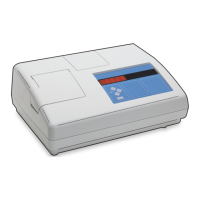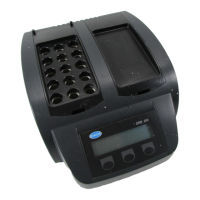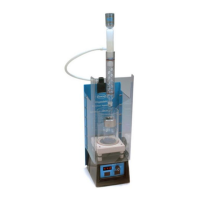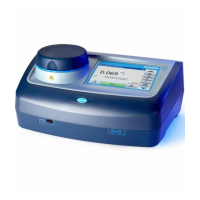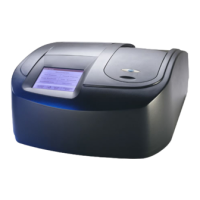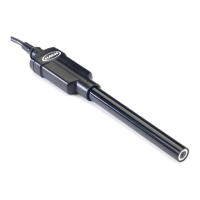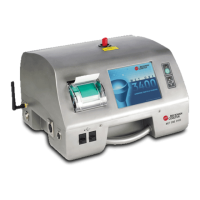What to do if Hach Laboratory Equipment shows ERR06?
- MMaria ParkerSep 9, 2025
If the Hach Laboratory Equipment displays ERR06, indicating an A/D under-range, check the light path for any obstructions.
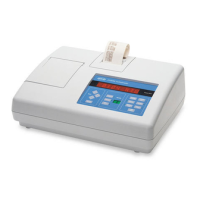
What to do if Hach Laboratory Equipment shows ERR06?
If the Hach Laboratory Equipment displays ERR06, indicating an A/D under-range, check the light path for any obstructions.
What does ERR12 mean on Hach Laboratory Equipment?
ERR12 on Hach Laboratory Equipment means there is an ASC units name error. Enter an ASC unit name that is not one of the default units (NTU, EBC, etc).
What does ERR13 mean on Hach 2100AN Laboratory Equipment?
ERR13 on Hach Laboratory Equipment means there is an ASC points error. ASC points must be entered in ascending NTU order, and at least two ASC points must be entered.
What does ERR14 mean on Hach 2100AN Laboratory Equipment?
ERR14 on Hach Laboratory Equipment means there is an invalid time error. The time must be between 00-00 and 23-59.
What does ERR15 mean on Hach 2100AN Laboratory Equipment?
ERR15 on Hach Laboratory Equipment means there is an invalid date error. The date must be between 01-00 and 12-31.
| Brand | Hach |
|---|---|
| Model | 2100AN |
| Category | Laboratory Equipment |
| Language | English |
Provides essential safety, regulatory, and product overview details.
Instructions for setting up the instrument and its components.
Explains the controls and displays of the instrument.
Guides on turning on the instrument and initial settings.
Covers calibration, sample preparation, and measurement procedures.
Critical safety warnings and hazard identification for instrument operation.
Details regulatory compliance and certifications for the instrument.
An introduction to the instrument's features and capabilities.
Explains the meaning of DANGER, WARNING, CAUTION, and NOTICE symbols.
Advises reading and observing instrument labels for safe operation.
Details regulatory compliance and certifications for the instrument.
Identifies and labels the front panel components of the instrument.
Illustrates and labels the rear panel connections and features.
Provides an illustrated list of all included instrument parts and accessories.
Step-by-step instructions for loading thermal paper into the instrument's printer.
Illustrates the instrument's keypad and labels each key.
Provides detailed descriptions for each key on the instrument's keypad.
Illustrates and labels the indicator lights on the instrument panel.
Details the function and meaning of each indicator light on the instrument.
Step-by-step guide to power on the turbidimeter and ensure proper setup.
Instructions for disabling the audible feedback from key presses.
Procedure for configuring the instrument's internal clock.
Instructions on how to view the instrument's current date and time display.
Detailed steps for calibrating the instrument using StablCal standards.
Guidance on cleaning, preparing, and mixing StablCal standard vials before use.
Important considerations and tips for successful calibration procedures.
Step-by-step visual guide for performing calibration with StablCal standards.
Recommendations for proper storage of StablCal calibration standards.
Instructions for using Gelex standards for calibration checks and optical system verification.
Important points and precautions for using Gelex secondary standards.
Procedure for measuring the Gelex stray light standard for instrument verification.
Steps to verify the instrument's calibration using Gelex secondary standards.
How to inspect the instrument's optical system integrity using the Gelex stray light standard.
Guidance on preparing sample cells for accurate turbidity measurements.
Detailed instructions for cleaning sample cells to ensure accurate readings.
Procedure for indexing a single sample cell for precise and repeatable measurements.
Method for matching multiple sample cells to minimize optical differences.
Instructions for preparing high-quality dilution water for sample preparation and calibration.
Guidelines for collecting and preparing samples that accurately reflect the source.
Methods for removing dissolved gases and air bubbles from samples.
Using vacuum to remove air bubbles from samples.
Employing ultrasonic waves to remove air bubbles from samples.
Using gentle heat to aid in bubble removal from samples.
Techniques to prevent condensation on sample cells during measurement.
Strategies to prevent instrument 'going blind' with high turbidity samples.
Procedure for diluting samples to bring them within the instrument's measurement range.
Tips for accurate and repeatable turbidity measurements.
Recommendations for instrument setup and operation for turbidity measurements.
Guidelines for selecting and using sample cells for turbidity measurements.
Step-by-step guide for performing turbidity measurements on samples.
Best practices for accurate absorbance and transmittance readings.
Detailed steps for performing absorbance and transmittance measurements.
Best practices for accurate color measurements.
Steps for calibrating and measuring color using the instrument.
Explanation of manual and automatic ranging modes for measurements.
How to use signal averaging to improve reading stability.
Explanation of the Ratio function and its impact on measurements.
Instructions for using the air purge system to prevent sample cell condensation.
Guidance on using a flow cell for enhanced measurement speed and accuracy.
Recommendations for storing the flow cell system when not in use.
How to set flow rates and flush the flow cell manually.
Instructions for controlling flow using the automated flow cell module.
Choosing between static and dynamic measurement modes for automated flow cells.
Setting the duration the flow valve remains open for sample filling.
Defining the interval during which the instrument measures the sample.
Important considerations before taking measurements with a flow cell.
Detailed steps for performing static or dynamic measurements using the automated flow cell.
Table listing minimum sample volumes required for different test tube sizes with cell adapters.
Instructions for inserting and preparing a cell adapter for sample measurement.
Steps for safely removing a cell adapter from the instrument.
Guidance on using different filter assemblies for various measurements.
Developing custom applications using optional filter assemblies and wavelengths.
Settings for controlling the instrument's built-in printer output.
Configuring serial port settings for computer communication.
List and explanation of RS232 commands for instrument control.
Instructions for connecting the instrument to an external data recorder.
Settings for managing data output to a connected data recorder.
Procedure for calibrating the instrument using formazin standards.
Steps for preparing formazin standards for instrument calibration.
Important considerations for formazin standard preparation and calibration.
Step-by-step guide for calibrating the instrument using formazin standards.
Instructions for preparing a 4000-NTU formazin stock solution from raw materials.
Calibrating the instrument using custom formazin standard values.
Preparing formazin standards with user-defined concentration values.
Adjusting calibration points to match user-defined standard values.
Using custom calibration (ASC) for non-standard units and applications.
Storing and using custom application calibration curves.
Example table showing standards for application specific calibration.
Entering initial calibration points for application specific calibrations.
Entering new data pairs for custom application specific calibrations.
Generating a printed record of application specific calibration data.
Modifying unit names or individual data points within ASC calibrations.
Removing a single data point from an application specific calibration.
Clearing all data points and resetting ASC unit names to defaults.
Routine cleaning procedures for the instrument's exterior.
Instructions for replacing the filter assembly in the instrument.
Steps for cleaning the lens of the filter assembly.
Procedures for safely replacing the instrument's lamp.
Illustrated guide for replacing the instrument's fuse.
Lists instrument error codes, their descriptions, and solutions.
Provides diagnostic codes for instrument operation checks.
Steps to remove user-entered calibration data from the instrument.
Explains the meaning of flashing '9s' on the display during measurements.
Explains the meaning of flashing '0s' on the display during measurements.
List of available replacement parts and optional accessories.
List of available replacement parts with quantities and item numbers.
List of optional accessories for the instrument.
List of optional chemical reagents available for use with the instrument.
